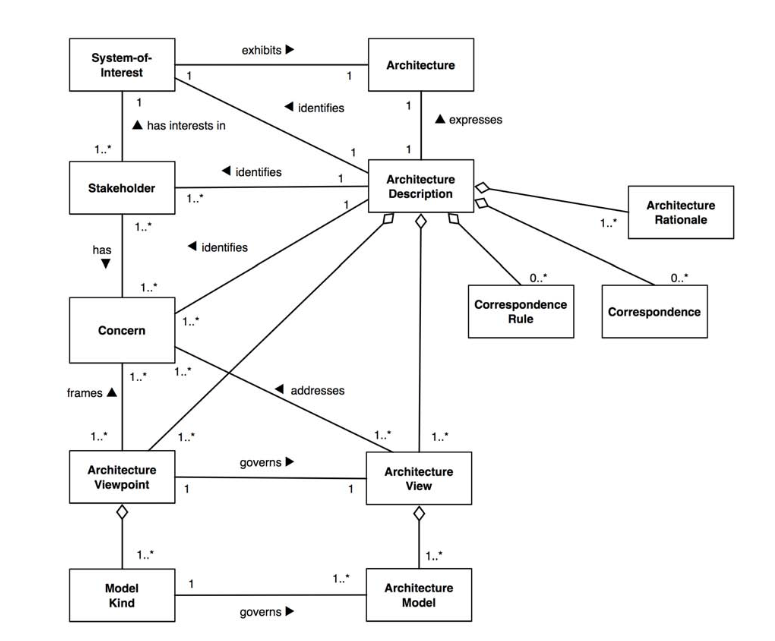ISO/IEC/IEEE 42010:2011 provides an ontology defining architecture elements, architecture frameworks and architecture description languages [11a].
Foundations of the ISO/IEC/IEEE 42010 Standard
The international standard ISO/IEC/IEEE 42010 (formerly IEEE 1471) defines a set of concepts as well as their properties and relations, that should be used when creating an architecture description of a system. It is currently available in version ISO/IEC/IEEE 42010:2011[11a].
The core concepts and relations specified in the standard are illustrated in Figure 1. The goal of applying this standard is to create an architecture description, which provides a basis for creating, analyzing and evolving the actual architecture of the system [11a]. An architectural description can be understood as being the conceptual model of the architecture, more precisely a specification of a conceptual model of the architecture [BKS10].

Figure 1: Conceptual model of an architecture description proposed by the ISO/IEC/IEEE 42010:2011 standard. [Source: ISO/IEC/IEEE 42010:2011 Systems and software engineering - Architecture description, Ingenierie des systemes et des logiciels - Description de l’architecture. Standard. International Organization for Standardization, 2011.]
The process of creating an architecture description usually starts with identifying stakeholders of the respective system and their concerns. Afterwards, views addressing these concerns are defined. Views are governed by their viewpoints and consist of sets of models. Correspondences describe the dependencies between the architecture elements (stakeholders, concerns, views, etc.) as well as between whole architecture descriptions. Architecture rationales are used to record architecture decisions and the reasoning behind them. The standard does not define specific architecture descriptions, views, viewpoints, models or model types, but rather the properties identifying elements as such [11a].
According to the standard, architecture frameworks and architecture description language should be based on the provided ontology. Additionally, further characteristics of architecture frameworks and architecture description languages are specified [11a].
The added value of this standard is the provision of a coherent practice for developing architecture descriptions, architecture frameworks and architecture description languages [11a].
Source:
|
[11a] |
ISO/IEC/IEEE 42010:2011 Systems and software engineering - Architecture description, Ingenierie des systemes et des logiciels - Description de l’architecture. Standard. International Organization for Standardization, 2011. |
|
[BKS10] |
S. Buckl, S. Krell, and C. Schweda. “A formal approach to Architectural Descriptions - Refining the ISO Standard 42010.” In: Advances in Enterprise Engineering IV - 6th International Workshop on Cooperation Interoperability - Architecture Ontology (CIAO2010), Lecture Notes in Business Information Processing (LNBIP). Vol. 49. St.Gallen: Springer, 2010, pp. 77–91. |